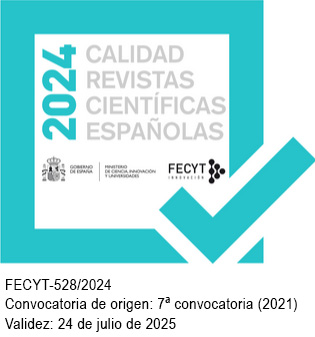Rethinking Stativity in Catalan: On Perfective Adjectives
doi: https://doi.org/10.31810/rsel.55.1.4
Keywords:
Perfective adjectives; stativity; result; stage-level predicates; CatalanAbstract
This paper describes and analyses perfective adjectives in Catalan. These adjectives coexist with a participle derived from the same root: buit – buidat, madur – madurat. Several diagnostics demonstrate that perfective adjectives can be divided into two groups: resultative adjectives, which always express a result, and attributive adjectives, which may or may not express a result. The detailed description of these two types of adjectives shows that both resultative adjectives and attributive adjectives used with a resultative interpretation constitute stage-level predicates; in contrast, attributive adjectives used with a non-resultative interpretation are individual-level predicates. Additionally, the type of result expressed by the adjective is compared to the one expressed by the participle, as these elements exhibit different syntactic behaviours. It is shown that the participle expresses an irreversible result, whereas the adjective expresses a reversible result. The analysis of perfective adjectives leads to a re-examination of the description of individual-level predicates and stage-level predicates in Catalan. It reveals that, regarding non-verbal predication in Catalan, stage-level predicates are always resultative.
Downloads
References
Anagnostopoulou, E. (2003). Participles and voice. En A. Alexiadou, M. R. and von Stechow, A. (Eds.), Perfect Explorations (pp. 1–36). Mouton de Gruyter. doi: https://doi.org/10.1515/9783110902358.1
Anagnostopoulou, E. (2017). Voice, manners, and results in adjectival passives. En R. D’Alessandro, I. Franco & G. Gallego (Eds.), The Verbal Domain (pp. 105–128). Oxford University Press. doi: https://doi.org/10.1093/oso/9780198767886.003.0005
Arche, M. J. (2006). Individuals in time: Tense, aspect and the individual/stage distinction, (vol. 94). John Benjamins Publishing. doi: https://doi.org/10.1075/la.94
Arche, M. J., Fábregas, A., & Marín, R. (2017). Towards a unified treatment of Spanish copulas. En S. Perpiñán, D. Heap, I. Moreno-Villamar & A. Soto-Corominas (Eds.), Romance languages and linguistic theory 11 (pp. 33–52). John Benjamins Publishing. doi: https://doi.org/10.1075/rllt.11.02arc
Ballesta i Roig, J. M. (1987). Algunes consideracions entorn dels verbs copulatius en català. Llengua i literatura, 359–375. https://raco.cat/index.php/LlenguaLiteratura/article/view/220341
Batllori, M., & Roca, F. (2012). Grammaticalization of Ser and Estar in Romance. En D. Jonas, J. Whitman & A. Garrett (Eds.), Grammatical Change: Origins, Nature, Outcomes (pp. 73–92). Oxford University Press.
Bazaco, C. (2020). Copulas in Spanish: scalar structure and interpretive economy. Borealis: An International Journal of Hispanic Linguistics, 9(2), 233–256. doi: https://doi.org/10.7557/1.9.2.5432
Beavers, J., & Koontz-Garboden, A. (2020). The roots of verbal meaning. Oxford University Press. https://doi.org/10.1093/oso/9780198855781.001.0001
Bosque, I. (1989). Adjetivos y verbos. Relaciones y diferencias. En I. Bosque (Ed.), Las categorías gramaticales: Relaciones y diferencias (pp. 163–177). Síntesis.
Bosque, I. (1999). El sintagma adjetival. Modificadores y complementos del adjetivo. Adjetivo y participio. En I. Bosque & V. Demonte (Coords.), Gramática descriptiva de la lengua española (pp. 217–310). Espasa Calpe.
Brucart, J. M. (2012). Copular alternation in Spanish and Catalan attributive sentences. Linguística: Revista de Estudos Linguísticos da Universidade do Porto, 7, 9–43. https://ler.letras.up.pt/uploads/ficheiros/10742.pdf
Camacho, J. (2012). Ser and estar: The individual/stage-level distinction and aspectual predication. En J. I. Hualde, A. Olarrea & E. O’Rourke (Eds.), The handbook of Hispanic linguistics (pp. 453–475). Blackwell Publishing. doi: https://doi.org/10.1002/9781118228098.ch22
Carlson, G. N. (1977). Reference to Kinds in English. Garland Publishing.
Chierchia, G, & Turner, R. (1988). Semantics and property theory. Linguistics and philosophy, 11, 261-302.
Crespí, I. (2024). Aspecte i estructura argumental de les passives resultatives: una aproximació nanosintàctica. Anuari de Filologia. Estudis de Lingüística, 14, 37–67. Recuperado a partir de https://revistes.ub.edu/index.php/AFEL/article/view/48742
CTILC = Institut d’Estudis Catalans: Corpus Textual Informatitzat de la Llengua Catalana. Recurso en línea: https://ctilc.iec.cat/scripts/index.asp
De Miguel, E. (1999). El aspecto léxico. En I. Bosque & V. Demonte (Coords.), Gramática descriptiva de la lengua española (pp. 2971-3060). Espasa Calpe.
Embick, D. (2004). On the structure of resultative participles in English. Linguistic Inquiry, 35(3), 355–392.
Fábregas, A. (2012). A guide to IL and SL in Spanish: Properties, problems and proposals. Borealis – An International Journal of Hispanic Linguistics 1(2), 1-71. doi: http://dx.doi.org/10.7557/1.1.2.2296
Fábregas, A. (2014). Un análisis sintáctico de dos tipos de causante. Estudios de Lingüística. Universidad de Alicante (ELUA), 28, 191–214. doi: https://doi.org/10.14198/ELUA2014.28.08
Fábregas, A. (2016). Las nominalizaciones. Visor libros.
Fábregas, A., & Marín, R. (2020). The Internal Structure of Perfective Adjectives: States and Blocking. Studies in Hispanic and Lusophone Linguistics, 13(2), 331–360. doi: https://doi.org/10.1515/shll-2020-2033
Falk, J. (1979). Visión de norma general versus visión de norma individual: ensayo de explicación de la oposición ser/estar en unión con adjetivos que denotan belleza y corpulencia. Studia Neophilologica, 51(2), 275–293.
Fernández Leborans, M. J. (1999). La predicación: las oraciones copulativas. En I. Bosque & V. Demonte (Coords.), Gramática descriptiva de la lengua española (pp. 2357-2460). Espasa Calpe.
Ferrater, G. (1981). Sobre el llenguatge. Edicions dels Quaderns Crema.
Gallego, Á. (2010). On the prepositional nature on non-finite verbs. Catalan Journal of Linguistics, 9, 79–102.
Gibert-Sotelo, E. (2017). Source and negative prefixes: On the syntax-lexicon interface and the encoding of spatial relations. Tesis doctoral, Universitat de Girona.
Gibert-Sotelo, E. (2022). Los participios adjetivales: clasificación y análisis sintáctico. Revista Signos. Estudios De Lingüística, 55(109), 501–531. Recuperado a partir de https://revistasignos.cl/index.php/signos/article/view/613
Gumiel-Molina, S. (2008). Sobre las diferencias entre ser y estar. El tipo de predicado y el tipo de sujeto. Revista electrónica de didáctica / español lengua extranjera (RedELE), 13, 1–19. https://sierrapambley.org/alumnos/wp-content/2008_redELE_13_02Gumiel.pdf
Gumiel Molina, S., Moreno-Quibén, N. & Pérez Jiménez, I. (2015). Comparison classes and the relative/absolute distinction: a degree-based compositional account of the ser/estar alternation in Spanish. Natural Language and Linguistic Theory, 33(3), 955–1001. doi: https://doi.org/10.1007/s11049-015-9284-x
Gumiel Molina, S., Moreno-Quibén, N. & Pérez Jiménez, I. (2018). Ser y estar en las lenguas romances ibéricas: las oraciones copulativas con atributo adjetival. Revista Española De Lingüística, 48, 153-198. doi: http://doi.org/0.31810/RSEL.48.5
Institut d’Estudis Catalans (2016). Gramàtica de la llengua catalana. Institut d’Estudis Catalans.
Jaque, M. (2014). La expresión de la estatividad en español: niveles de representación y grados de dinamicidad. Tesis doctoral, Universidad Autónoma de Madrid.
Jaque, M. (2020). Dos formas de ser un estado resultante. Onomázein, Revista de lingüística, filología y traducción, 50, 205-247. DOI: 10.7764/onomazein.50.11
Kennedy, C., & McNally, L. (2005). Scale Structure, Degree Modification, and the Semantics of Gradable Predicates. Language, 81(2), 345-381. Recuperado a partir de https://semantics.uchicago.edu/kennedy/docs/km-scales05.pdf
Kratzer, A. (1994). The event argument and the semantics of voice. Manuscrito. University of Massachusetts. Amherst.
Kratzer, A. (2000). Building Statives. Annual Meeting of the Berkeley Linguistics Society, 26(1), 385–399. doi: https://doi.org/10.3765/bls.v26i1.1131
Leonetti, M. (1994). Ser y estar: estado de la cuestión. Pliegos de la Insula Barataria revista de creación literaria y de filología, 1, 182–205. http://hdl.handle.net/10017/6986
Luján, M. (1981). The Spanish copulas as aspectual indicators. Lingua, 54(2-3), 165–210. doi: https://doi.org/10.1016/0024-3841(81)90068-1
Lundquist, B. (2008). Nominalizations and Participles in Swedish. Tesis doctoral, Universidad de Tromsø.
Maienborn, M. (2005). A discourse-based account of Spanish ser/estar. Linguistics, 43(1), 155–180. doi: https://doi.org/10.1515/ling.2005.43.1.155
Maienborn, M. (2007). On Davidsonian and Kimian States. En I. Comorovski & K. Von Heusinger (Eds.), Existence: Semantics and Syntax (pp. 107-30). Springer. doi: https://doi.org/10.1007/978-1-4020-6197-4_4
Marín, R. (1998). Participios con aspecto de adjetivos: entre la diacronía y la morfología. Moenia. Revista lucense de lingüística e literatura, 3, 365–376. http://hdl.handle.net/10347/5927
Marín, R. (2004). Entre ser y estar. Arco Libros.
Marín, R. (2010). Spanish Adjectives within bounds. En P. Cabredo Hofherr & O. Matushansky (Eds.), Formal Analyses in Syntax and Semantics (pp. 307-332). John Benjamins. doi: https://doi.org/10.1075/la.153.09mar
Milsark, G. L. (1974). Existential sentences in English. Tesis doctoral, MIT.
Parsons, T. (1990). Events in the semantics of English: a study in subatomic semantics. MIT Press.
Penny, R. (2005). Gramática histórica del español. Ariel.
Ramchand, G. (2008). Verb Meaning and the Lexicon: A first-phase syntax. Cambridge University Press.
Ramchand, G. (2018). Situations and syntactic structures: Rethinking auxiliaries and order in English, (vol. 77). MIT Press.
Ramos, J. R. (2000). Ésser, estar i haver-hi en català antic: estudi sintàctic i contrastiu, (vol. 51). Universitat de València.
Ramos, J. R. (2002). El SV, II: la predicació no verbal obligatòria. En J. Solà, M. R. Lloret, J. Mascaró & M. Pérez Saldanya (Dirs.), Gramàtica del català contemporani (pp. 1951–2044). Empúries.
Real Academia Española de la Lengua y Asociación de Academias de la Lengua Española. (2009). Nueva Gramática de la Lengua Española. Espasa.
Real Academia Española de la Lengua y Asociación de Academias de la Lengua Española (2019). Glosario de términos gramaticales, (vol. 44). Ediciones Universidad de Salamanca.
Rosselló, J. (2002). El SV, I: Verb i arguments verbals. En J. Solà, M. R. Lloret, J. Mascaró & M. Pérez Saldanya (Dirs.), Gramàtica del català contemporani (pp. 1853-1949). Empúries.
Silvagni, F. (2017). Entre estados y eventos: un estudio del aspecto interno del español. Tesis doctoral, Universitat Autònoma de Barcelona.
Thomas, A. (2019). The development of double past participle forms in Portuguese. [Comunicación oral]. International Conference on Historical Linguistics, Australian National University, Canberra, Australia. https://users.ox.ac.uk/~mert3107/res/ICHLhandout.pdf
Published
How to Cite
Issue
Section
Copyright (c) 2025 Revista Española de Lingüística

This work is licensed under a Creative Commons Attribution-NonCommercial-NoDerivatives 4.0 International License.










